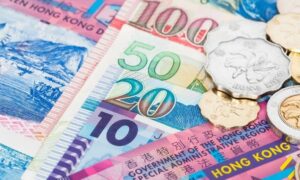 The Hong Kong dollar or Hong Kong dollar is the legal currency of circulation in the Hong Kong Special Administrative Region of the People’s Republic of China. According to the “Basic Law of the Hong Kong Special Administrative Region of the People’s Republic of China”, the legislative autonomy of the Hong Kong Special Administrative Region includes the power to issue currency on its own. Its official ISO 4217 is abbreviated as HKD (Hong Kong Dollar); the symbol is HK$.
The Hong Kong dollar or Hong Kong dollar is the legal currency of circulation in the Hong Kong Special Administrative Region of the People’s Republic of China. According to the “Basic Law of the Hong Kong Special Administrative Region of the People’s Republic of China”, the legislative autonomy of the Hong Kong Special Administrative Region includes the power to issue currency on its own. Its official ISO 4217 is abbreviated as HKD (Hong Kong Dollar); the symbol is HK$.
The HK$10 banknotes and various coins are issued by the Hong Kong Monetary Authority, and the HK$20 and above banknotes are issued by Bank of China, HSBC and Standard Chartered Bank. The current denominations of banknotes in circulation are 10 yuan, 20 yuan, 50 yuan, 100 yuan, 500 yuan and 1000 yuan, and the denominations of coins are 10 yuan, 5 yuan, 2 yuan, 1 yuan, 5 cents, 2 cents and 1 cents. 1 yuan = 10 milliliters = 100 points. In Hong Kong, “milli” means “horn”.
The Hong Kong Monetary Authority and the three Hong Kong note-issuing banks, Bank of China, HSBC and Standard Chartered, announced on July 24, 2018, the launch of the 2018 version of the new series of Hong Kong dollar banknotes.
Hong Kong has established a linked exchange rate system in which the issuance of Hong Kong dollars is pegged to the US dollar. The US dollar held by the Exchange Fund provides support for the stability of the Hong Kong dollar banknotes.
Hong Kong is the third largest financial center in the world after New York and London, thus making the Hong Kong dollar one of the currencies with a sound system and a stable currency value. Although the history of Hong Kong dollar issuance is not long and the area is not large, its development has a certain representativeness.
The vast majority of Hong Kong dollar banknotes are issued by three note-issuing banks under the supervision of the Hong Kong Monetary Authority. The three note-issuing banks include HSBC, Standard Chartered and Bank of China. There is also a new purple ten-dollar note, which is self-issued by the Hong Kong Monetary Authority. Coins are issued by the Monetary Authority. Since 1983, Hong Kong has established a linked exchange rate system in which the issuance of the Hong Kong dollar is pegged to the US dollar. When issuing any amount of Hong Kong dollars, note-issuing banks must hand over U.S. dollars to the HKMA at the exchange rate of 7.80 Hong Kong dollars to 1 U.S. dollar, which will be credited to the account of the Exchange Fund. In this way, the US dollar held by the Exchange Fund provides support for the stability of Hong Kong dollar banknotes.
It is worth noting that the styles of all banknotes in Hong Kong are copyrighted. Therefore, no one can arbitrarily reproduce the style of banknotes without the permission of the copyright holder. Over the years, several organisations in Hong Kong have been sentenced to pay hefty fines for advertising the use of banknotes without the approval of the bank that holds the copyright of the banknotes.
Although the Hong Kong dollar has legal status only in Hong Kong, it is also accepted in many places in mainland China and the Macau SAR. Also, in Macau casinos, only Hong Kong dollars are accepted outside the pataca.
The first banknotes in Hong Kong were issued by the Agricole Bank in 1845, but they were not really in general circulation for a long time. Until 1857, the Hong Kong government allowed the use of banknotes to pay fees, and then many banks began to issue banknotes one after another. By 1865, banknotes issued by 5 banks were recognized by the Hong Kong government, but banknotes below 5 yuan were not issued unless special permission was issued. The real currency unit was the Hong Kong dollar in November 1935.
After 1945, the currency in circulation in Hong Kong was issued by three banks, namely HSBC, Standard Chartered and Lili Bank, and the government issued the currency below 1 yuan. By 1959, Lili Bank was acquired by HSBC. During this period, Hong Kong dollar banknotes were issued by HSBC and Standard Chartered Bank, and coins below 5 yuan were issued by the government. In 1994, Bank of China began to issue banknotes in Hong Kong. As of 2012, three banks in Hong Kong have issued banknotes, namely HSBC, Bank of China and Standard Chartered. The three banks that issue banknotes in Hong Kong generally do not announce the suspension of circulation of the old banknotes. Since 1993, the new banknotes issued by HSBC and Standard Chartered have replaced the colonial-inspired designs with lion heads and redbuds. Older banknotes can still be used, but will be gradually withdrawn from circulation.